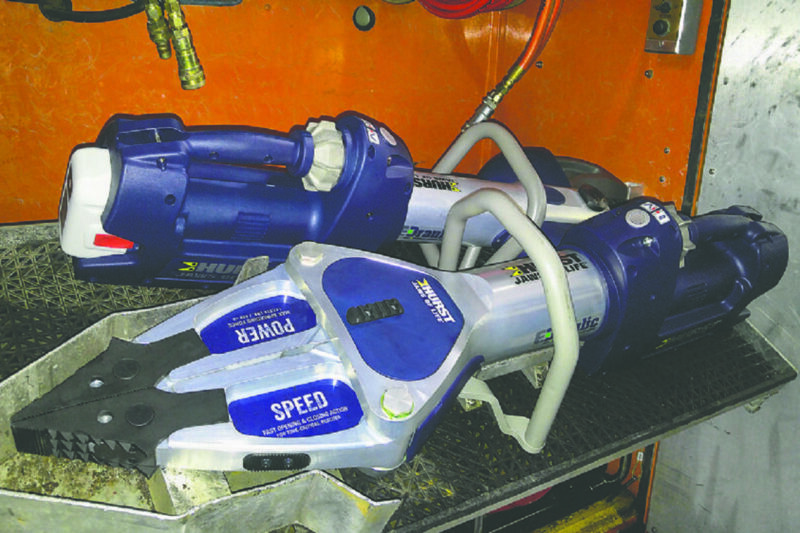Sean C. Morgan
The Sweet Home Fire and Ambulance District took delivery of new extrication tools last week, its first major purchase under a six-year $1.575 million bond approved by voters in November, and it won a federal grant that will allow it to hire additional medics.
The district received seven battery-powered Hurst Jaws of Life tools, including two spreaders, two cutters, one ram and two combination tools at a cost of $64,500 on July 10.
Previously, the district paid about $7,000 to install a new repeater off High Deck Road to improve radio communications in the Quartzville corridor and east along Highway 20.
The district installed a full set of the Jaws of Life on Rescue 21, the orange rescue engine that is its first-out rescue unit, said Fire Chief Dave Barringer. The district is planning to keep Rescue 21 for the time being and replace just one of its two rescue units, Rescue 25.
Older hydraulic tools will remain aboard Rescue 21 as backup, Barringer said. The district is buying mounts to install a spreader and cutter on Engine 22, and a combination tool is on Engine 21, the district’s first-out engine.
The district’s top priority right now is replacing air packs, Barringer said. The district continues to await a decision on a federal grant that could pay for them. If the district does not win the grant, it will need to spend about $258,000 to replace its air packs. The current equipment, self-contained breathing apparatus (SCBA), is reaching the end of the 15-year certified lifespan.
Vehicle-wise, the district has an ambulance under construction in Ohio, Barringer said. The ambulance box is being placed on a new chassis and should return to Sweet Home in September or October, costing about $100,000.
A new tank and pump are being placed on a used military chassis in Prineville to provide the district a new water tender, Barringer said. He anticipates the tender will be finished in September. The district bought the chassis for $1,100 from a federal fire program. The cost of the tender will be about $80,000.
Up next will be replacement of Rescue 25 and the battalion chief’s brush rig.
Rescue 25, the smaller rescue unit based at the main station, is overweight, and its electrical system is inadequate, Barringer said. The replacement will cost about $215,000.
The battalion chief’s response vehicle will cost about $120,000 and provide the flexibility the battalion chiefs need when they respond to calls, Barringer said. The three battalion chiefs are usually the first to arrive on calls and may need to take a wide variety of actions.
The current battalion chief brush rig will move to Crawfordsville, Barringer said. The current Crawfordsville brush rig, a 2000 Ford F550 the board chose to purchase for $9,200 from Tillamook, replacing a 1989 Ford, will move to Foster. The district will surplus its oldest brush rig, a Dodge currently at Cascadia – ultimately updating brush rigs at each station.
Also planned are repairs to district facilities. SHFAD’s priority is adding a third vehicle bay at Foster Station, located off 47th
Avenue, to accommodate the vehicles parked at the station, Barringer said. “We’re going to start looking for bids.”
The district has talked to a couple of different people about designs for the bay, he said. The goal is to find the most efficient way to add onto the structure.
Next on the list for building priorities will be the remodeling of the main station sleeping quarters, Barringer said, then a new volunteer association building. After that, the district will remodel the main station kitchen area.
Elsewhere in its finances, the district is getting a boost after winning a $339,000 Staffing for Adequate Fire and Emergency Response Grant from the U.S. Federal Emergency Management Agency.
“Staffing has been an issue with increases in call volume,” Barringer said. “We hope this will help on fire response and keep medical staff available.”
The three-year grant will pay for two new paramedics, who will work regular day shifts, Barringer said. It covers 70 percent of the cost for two years and 30 percent of the cost in the third year.
“The goal for the federal grant is you end up taking those people on full-time,” Barringer said. Overall, the district’s budget is looking better.
Last year, fiscal 2016-17, which ended June 30, the district budgeted $725,000 in ambulance revenue, Barringer said. It ended the year with $836,000.
The district is no longer borrowing money, he said. “The budget is showing improved health.”
A bill passed by the state government this year allows the district, effective July 1, to pursue additional federal reimbursement for Medicaid patients transported by ambulance, Barringer said. Previously, the district has received $421 per trip. Under the new law, he anticipates reimbursements of about twice that amount. The district handled more than 300 Medicaid patient trips last year.
The reimbursement “will help us retain personnel,” Barringer said.
“To get $339,000 for staffing creates hope in a budget that was really a concern,” he said. Planning for the future is easier “when you have the staff to meet the needs of the community.”





